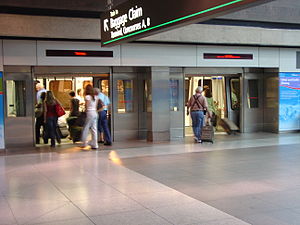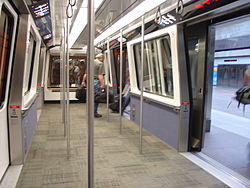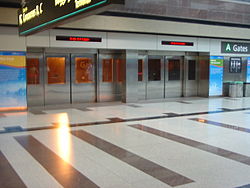- Denver International Airport Automated Guideway Transit System
-
DIA Automated Guideway Transit System
Concourse C PlatformOverview Type People mover Locale Denver International Airport serving Denver Termini Terminal/Ground Transportation/Baggage Claim
Concourse CStations 4 Operation Opened February 28, 1995 Operator(s) City & County of Denver Department of Aviation Character Serves sterile parts of the airport Rolling stock 31 Bombardier Innovia APM 100 vehicles Technical Line length 1.25 mi (2 km) Highest elevation Underground Route map Legend

Terminal / Ground Transportation / Baggage Claim 

A Gates 

B Gates 

C Gates The Denver International Airport Automated Guideway Transit System is a people mover system operating at Denver International Airport in Denver, Colorado. The system opened along with the airport itself in 1995, and was conceived as a means to connect all of the midfield concourses with the south terminal and quickly transport passengers between them because of the longer distances between each building, especially when compared to Stapleton International Airport, Denver's former airport.[1]
Contents
History
The AGTS project was announced publicly in October 1992 at a cost of $84 million. The initial system consisted of 16 cars that were paired together in groups of four to traverse the length of the tunnel.[1] The cars themselves ride on rubber wheels and roll along a concrete track. Additionally, crossover tracks exist between each station, so traffic can be routed around stalled or disabled trains if necessary.[1]
Six more vehicles were added to the system by 1995, and an additional five were added in 2001. Today, the fleet consists of 31 Bombardier Innovia APM 100 vehicles, which have a maximum capacity of 100 passengers.[2] Trains generally run at 1.5 minute intervals during peak times resulting in an 11 minute travel time from end to end.[3]
Layout and Operation
Located within the secure areas of the airport, the AGTS utilizes two mile-long tunnels traveling underneath the aircraft taxiways. Four stations exist, serving each airside concourse (Concourses A, B, and C) and the Terminal (which serves Ground Transportation and Baggage Claim). While it is possible to walk from the main terminal to Concourse A via a pedestrian bridge over the taxiway, the train is the only way for the public to access Concourses B and C.
Each station features an island platform configuration, and is equipped with platform screen doors. The Terminal station, the southernmost station, also features additional outboard platforms at each track. In accordance with the Spanish solution, when a train arrives at the Terminal, the outboard doors open first to allow arriving passengers to exit. The inboard doors then open, allowing departing passengers to board. Currently, all trains use the west platform in the Terminal station, and the east platform is not used for passenger service, and is only occasionally used to store non-operating trains. At the Terminal station, trains reverse direction, and use a switch at a crossover located just north of the station to switch into the northbound tunnel.
The system also includes a maintenance facility, which is located just beyond the Concourse C station.
Since Denver International Airport was designed based upon the layout of Hartsfield-Jackson Atlanta International Airport, the AGTS's layout is nearly identical to the layout of The Plane Train.
Audio
The AGTS features an audio system which deliver station information, as well as arrival and departure information to passengers on the trains and platforms. The audio utilizes pre-recorded messages that are delivered by well known voice talent from the Denver area, and are each preceded by a variety of short musical sound effects. The voices and sound effects were recorded by Denver sound artist Jim Green, and they make up one of the airport's public art installations known as "Train Call." Jim Green is also known for recording the audio for the singing sinks in the restrooms at the Denver Art Museum and the "Laughing Escalators" at the Denver Convention Center.
The recordings currently feature the voices of former Coors Field announcer Alan Roach, and local KUSA-TV anchor Adele Arakawa. Denver Mayor Michael Hancock delivers a "Welcome to Denver" greeting that plays prior to arriving at the Terminal and Baggage Claim station. His welcome includes portions in both Spanish and English. The current sound effects feature a contemporary music theme, and include sounds from pianos, synthesizers, and electric guitars. The current audio debuted in June of 2007.[4]
With two separate voices, the stations are configured so that one voice delivers information for trains on one side of the platform, while the other voice delivers information for the other side. The trains are configured so that the voice alternates between each of the train's four cars, so that one voice is installed on the first and third cars, while the other voice is installed on the second and fourth cars. Mayor Vidal's voice delivers the "Welcome to Denver" greeting regardless of which voice is installed on the individual car. Each of the announcements is preceded by its own individual sound effect. There are even separate sound effects for the same message, depending on which voice delivers it. The exception to this is the message that announces that the doors are closing, which always has the same sound effect since it is a warning message.
Originally, the audio featured the voices of local radio broadcaster Pete Smythe and former KCNC-TV anchor Reynelda Muse, who was also the first African-American woman to anchor a local news program in Denver. The original sound effects featured a more whimsical circus-like theme, and some of them were based on western folk songs, such as "She'll Be Coming 'Round the Mountain" and "Home on the Range."[5] The original audio had been used on the system since the airport's opening in 1995 and remained unchanged for 12 years, primarily due to the status of being a public art installation. The original audio was ultimately replaced due to various changes made at the airport since its opening. The most noticeable change made to the messages themselves was the reference to the concourse stations. The original audio announced "Please hold on. This train is approaching Concourse A," where it now says "Hold on please. We are approaching the station for all 'A' Gates." Station signage was also changed to reflect this. This change was made since some people found the term "concourse" confusing. Some information regarding Baggage Claim monitors in the Terminal station also caused confusion and needed to be removed from the messages, since the monitors themselves were removed from the station years prior. The "Welcome to Denver" greeting as added to the audio along with the current audio in 2007. Although, it originally featured the voice of then-Mayor John Hickenlooper. In January of 2011, the recording was updated to include current Mayor Bill Vidal, who replaced Hickenlooper after he was elected Governor of Colorado. Vidal's version of the spiel is identical to the original, except that he also says the Spanish translation of the phrase, "Bienvenidos a Denver," before giving the information about how to get to baggage claim and ground tranportation (which does not get repeated in Spanish). After Michael Hancock was inaugurated as Denver's Mayor his voice replaced Vidal's. Hancock's greeting is "Welcome to Denver, the Mile High City."
Tunnel Artwork
The train system's tunnels are home to two of the airport's visual art exhibits. These art installations were created since nearly one percent of the total budget for the construction of Denver International Airport was dedicated to artwork. The artwork interacts with the passing trains and can be viewed through the train's windows as they travel through the tunnels.
Kinetic Light Air Curtain
The northbound tunnel features an art exhibit known as the "Kinetic Light Air Curtain." Designed by Antonette Rosato and William Maxwell, the exhibit includes 5,280 propellers mounted on the wall. The propellers are accented with blue fluorescent light, and wind from the trains causes some of them to spin as they pass by. The number of propellers represents the number of feet Denver (the mile-high city) is located above sea level. Also, the total number of blades of all of the propellers combined represents the height of Colorado's tallest fourteener, Mount Elbert, which is 14,440 feet tall. Contrary to common belief, the propellers do not generate any electricity for the trains or any part of the airport, and are strictly decorative.[6]
Deep Time/Deep Space, a Subterranean Journey
The southbound tunnel contains the exhibit "Deep Time, Deep Space: A Subterranean Journey." Designed by Leni Schwendinger, this art display primarily consists of over 5,000 feet of colored reflective metal strips arranged into a variety of images. Various other items, sheet metal cut-outs of pick axes and hammers stand out from the tunnel walls to accent the scenes. The exhibit gradually transitions from displaying examples of older technology to newer space-age technology. The art is lighted by an advanced lighting system, which is activated by photoelectric sensors which detect passing trains. The overall work is inspired by Colorado's industrial and mining history.[7]
Failure
While the AGTS is a highly reliable system, one major system failure took place on April 26, 1998. A routing cable in the train tunnel was damaged by a loose wheel on one of the trains, cutting the entire system's power and shutting it down. The entire system was out of service for about seven hours, so a fleet of thirty shuttle buses had to be deployed to transport passengers between the concourses since there are no pedestrian walkways connecting to Concourses B and C. United Airlines, DIA's largest airline (who operates out of Concourse B), reported that about 30 percent of their flights and about 5,000 passengers were affected by the failure.[8] The day of the failure is now referred to as "Black Sunday" by airport personnel.[9]
In popular culture
The train system is also mentioned in Lee Child's novel Bad Luck and Trouble. The novel's antagonist, who flies into DIA, enjoys the musical sound effects that precede the announcements as he travels from his arrival gate to the terminal on the train. The novel states that the antagonist was "smiling all the same at the crazy bursts of jug-band music that preceded the station announcements." The novel references the original sound effects which accompanied the original Pete Smythe and Reynelda Muse announcements.[10]
References
- ^ a b c Weber, Brian (October 25, 1992). "Fliers can ride the rails on $84 million subway". The Rocky Mountain News.
- ^ Bombardier Transportation - Denver International Airport
- ^ The Train (Or Automated Guideway Transit System) (Denver Internaional Airport)
- ^ Flynn, Kevin (2007-05-07). "New voices coming for DIA trains". The Rocky Mountain News. http://www.rockymountainnews.com/drmn/local/article/0,1299,DRMN_15_5524450,00.html.
- ^ "Train Call (Jim Green - Sound Art Installation)". http://JIMGREEN.ORG/artwork/874821_Train_Call.html. Retrieved 2011-04-26.
- ^ "Kinetic Light Air Curtain" (Denver International Airport: Public Art Installations)
- ^ "Deep Time/Deep Space, a Subterranean Journey" (Denver International Airport: Public Art Installations)
- ^ "Train Accident Disrupts Denver Airport Service". The New York Times. 1998-04-27. http://query.nytimes.com/gst/fullpage.html?res=9D00E7DC1E3FF934A15757C0A96E958260.
- ^ Zoglin, Richard; Sally B. Donnelly (2002-07-15). "Welcome to America's Best Run Airport". Time Magazine: pp. 3. http://www.time.com/time/magazine/article/0,9171,1002855-1,00.html.
- ^ Calhoun, Patricia (2007-08-01). "Bad Guy, Good Music". Westward. http://blogs.westword.com/latestword/2007/08/bad_guy_good_music.php.
External links
- Official Denver International Airport website
- YouTube Video of the Train #1 (Old Audio)
- YouTube Video of the Train #2 (New Audio)
People mover systems at airports in North America Current Atlanta (Plane Train · Skytrain) · Chicago O'Hare · Cincinnati · Dallas-Fort Worth (DFW Skylink) · Denver · Detroit · Houston Bush Intercontinental (TerminaLink · Inter-Terminal Train) · Las Vegas · Mexico City · Miami (Concourse E · Skytrain · MIA Mover) · Minneapolis-St. Paul · New York JFK · Newark · Orlando · Pittsburgh · San Francisco · Seattle-Tacoma · Tampa · Toronto Pearson · Washington DullesFuture Defunct Dallas-Fort Worth (Aitrans/TrAAin)Categories:- Public transportation in Colorado
- Transportation in Denver, Colorado
- Airport people mover systems
- Innovia people movers
- Denver International Airport
Wikimedia Foundation. 2010.





